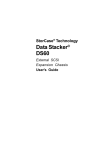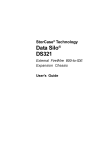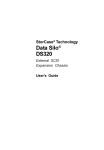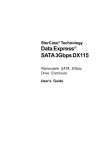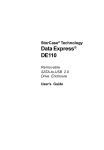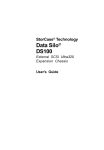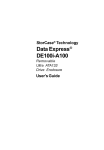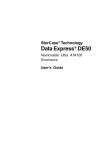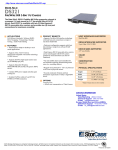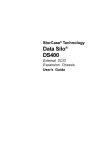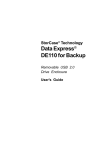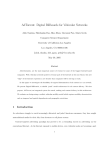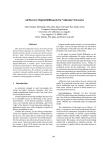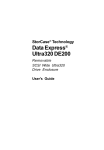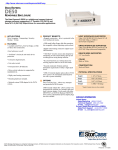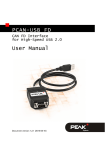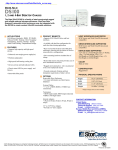Download StorCase InfoStation S11J100
Transcript
StorCase® Technology InfoStation® 5-Bay SATA 3Gbps RAID External Expansion Chassis User's Guide i StorCase® Technology InfoStation® 5-Bay SATA 3Gbps RAID External Expansion Chassis User's Guide Part No. P89-0000-0293 C00 June 2006 StorCase Technology, Inc. 17600 Newhope Street Fountain Valley, CA 92708-9885 Phone (714) 438-1850 Fax (714) 438-1847 InfoStation 5-Bay RAID User's Guide - Rev. C00 StorCase Technology, Inc. ii LIMITED WARRANTY STORCASE TECHNOLOGY, Incorporated (“StorCase”) warrants that its products will be free from defects in material and workmanship, subject to the conditions and limitations set forth below. StorCase will, at its option, either repair or replace any part of its product that proves defective by reason of improper workmanship or materials. Repair parts or replacement products will be provided by StorCase on an exchange basis, and will be either new or reconditioned to be functionally equivalent to new. This warranty does not cover any product damage that results from accident, abuse, misuse, natural or personal disaster, external power surge or failure, or any unauthorized disassembly, repair or modification. StorCase will not be responsible for any software, firmware or other customer data stored within, or interfacing with a StorCase product. Duration of Warranty Twelve-Year Warranty: The following StorCase products are covered by this warranty for a period of twelve (12) years from the original date of purchase from StorCase or its authorized resellers: all Data Express® Profile (model types "DX") removable device enclosures. Seven-Year Warranty: The following StorCase products are covered by this warranty for a period of seven (7) years from the original date of purchase from StorCase or its authorized resellers: all Data Express Classic (model types "DE") removable device enclosures and all Data Silo®, Data Stacker® and InfoStation® external expansion chassis, except for those components integrated into or purchased separately for use with these products which are identified and covered by the three-year or hard drive warranties described below. All StorCase interface cables and other accessories specifically intended for use with the StorCase products identified above are also covered by this (7) year warranty. Three-Year Warranty: The following components integrated into or purchased separately for use with StorCase Data Express, Data Silo, Data Stacker and/or InfoStation products are subject to warranty for a period of three (3) years from the original date of purchase from StorCase or its authorized resellers: all RAID controllers, power supplies, fans and blowers. Two-Year Warranty: The following StorCase products are covered by this warranty for a period of two (2) years from the original date of purchase from StorCase or its authorized resellers: all Rhino®JR fixed external expansion chassis (model types “FJR”) and all RhinoJR removable device enclosures (model types “RJR”). One-Year Warranty: All StorCase products identified as Reconditioned or “Special Inventory” are covered by this warranty for a period of one (1) year from the original date of purchase from StorCase or its authorized resellers. Reconditioned products may only be exchanged for reconditioned products. Hard Disk Drive Warranty: All hard disk drives purchased from StorCase or through its authorized resellers, whether purchased separately or integrated into StorCase products, are subject to the warranty terms and conditions provided by the drive manufacturer. Third Party Software Warranty: All third party software purchased from StorCase for use with and/or as part of StorCase products is subject to the warranty terms and conditions provided by the software manufacturer. StorCase Technology, Inc. InfoStation 5-Bay RAID User's Guide - Rev. C00 iii Warranty Claim Requirements To obtain warranty service, the defective product must be returned to your local authorized StorCase dealer or distributor, or, with prior StorCase approval, to the StorCase factory service center. For defective products returned directly to StorCase, a Return Material Authorization (“RMA”) number must be obtained by calling StorCase Customer Service at (714) 445-3455. The RMA number must be prominently displayed on the outside of the return package. Shipments must be freight-prepaid and insured, and must include the product serial number, a detailed description of the problem experienced, and proof of the original retail purchase date. Products must be properly packaged to prevent damage in transit. Damage resulting from improper packaging will not be covered by this warranty. The StorCase factory service center is located at 17650 Newhope Street, Receiving Dock, Gate #4, Fountain Valley, CA 92780, U.S.A. Free Technical Support StorCase provides free technical support. If you experience any difficulty during the installation or subsequent use of a StorCase product, please contact StorCase’s Technical Support Department prior to servicing your system. This warranty covers only repair or replacement of defective StorCase products, as described above. StorCase is not liable for, and does not cover under warranty, any costs associated with servicing and/or installation of StorCase products. StorCase Technical Support can be reached in the U.S. at (714) 438-1858 or toll-free at (888) 435-5460 (U.S. and Canada only). StorCase European Technical Support can be reached in the U.K. at +44 (0) 1932 738900. Disclaimers The foregoing is the complete warranty for the products identified above and supersedes all other warranties and representations, whether oral or written. StorCase expressly disclaims all warranties for the identified products, which are not stated herein, including, to the extent permitted by applicable law, any implied warranty of merchantability or fitness for a particular purpose. In no event will StorCase be liable to the purchaser, or to any user of a StorCase product, for any damages, expenses, lost revenues, lost savings, lost profits, or any other incidental or consequential damages arising from the purchase, use or inability to use a StorCase product, even if StorCase has been advised of the possibility of such damages. Copyright © 2006 StorCase Technology. All rights reserved. All registered trademarks are the property of StorCase Technology. All other logos and trademarks are properties of their respective companies. InfoStation 5-Bay RAID User's Guide - Rev. C00 StorCase Technology, Inc. iv Declaration of Conformity Company Name: StorCase Technology, Inc. Corporate Office Address: 17600 Newhope Street Fountain Valley, CA 92708 Manufacturing Address: 17600 Newhope Street Fountain Valley, CA 92708 Product Name: InfoStation 5-Bay SATA RAID Chassis Model Number: S11J104 Conforms to the following standards: EMC Directives: (89/336/EEC) ITE Emission - EN 55022: 1998 - EN 61000-3-2 Harmonic Current - EN 61000-3-3 Voltage Fluctuations and Flicker EN 55024: 1998 ITE Immunity - IEC 61000-4-2 - IEC 61000-4-6 - IEC 61000-4-3 - IEC 61000-4-8 - IEC 61000-4-4 - IEC 61000-4-11 - IEC 61000-4-5 Low Voltage Directive: (73/23/EEC) EN 60950 Safety Standards: CSA (NRTL/C) CAN/CSA-C22.2 No. 60950-1-03 UL 60950-1, First Edition EMI Standards: FCC Part 15, Class B EMC Standards: AS/NSZ 3548 Information Technology Equipment Supplier's Code Number N10664 Year of Manufacture: 2006 Signature:___________________ Full Name: Dieter Paul Position: President StorCase Technology, Inc. InfoStation 5-Bay RAID User's Guide - Rev. C00 v Federal Communications Commission (FCC) Statement RADIO FREQUENCY INTERFERENCE STATEMENT You are cautioned that changes or modifications not expressly approved by the party responsible for compliance could void your authority to operate that equipment. This device complies with part 15 of the FCC rules. Operation is subject to the following two conditions: (1) This device may not cause harmful interference, and (2) This device must accept any interference received, including interference that may cause undesired operation. Important Safety Instructions 1. Read all these instructions. 2. Save these instructions for later use. 3. Follow all warnings and instructions marked on the product. 4. Do not use this product near water. 5. This product should be operated from the type of power source indicated on the marking label. If you are not sure of the type of power available, consult your dealer or local power company. 6. Do not attempt to service this product yourself, as opening or removing covers may expose you to dangerous voltage points or other risk. Refer all servicing to service personnel. 7. Handling certain plastic coated cords or cables associated with this product may expose you to lead, a chemical known to cause birth defects or other reproductive harm. Wash your hands after handling cable(s). Wichtige Sicherheitshinweise 1. Diese Hinweise sollten vollständig durchgelesen werden. 2. Diese Hinweise für einen späteren Gebrauch aufbewahren. 3. Allen auf dem Gerät angebrachten Warnungen und Hinweisen folgen. 4. Das Gerät nicht in der Nähe von Wasser verwenden. 5. Das Gerät nur mit dem Aufkleber bezeichneten Netzspannung betreiben. Bei Fragen über die Art der Netzspannung sollte der Händler oder das Energieversorgungsunternehmen zu rate gezogen werden. 6. Nicht versuchen das Produkt selbst zu reparieren. In allen Produkten existieren gefährliche elektrische Spannugen. Nicht das Gehäuse öffnen. 7. Wartungsarbeiten nur von qualifiziertern Kundendienstpersonal ausführen laßen. InfoStation 5-Bay RAID User's Guide - Rev. C00 StorCase Technology, Inc. vi Table of Contents INTRODUCTION ..................................................................................................................... Packaging Information ...................................................................................................... Serial Number ................................................................................................................ General Description .......................................................................................................... Front Panel .................................................................................................................... Rear Panel ..................................................................................................................... 1 1 1 2 4 6 CONTROLLER MODULE PANEL ............................................................................................ Panel Components ........................................................................................................ Inserting a Drive Carrier (with Drive Installed) ................................................................ Removing a Drive Carrier (with Drive Installed) .............................................................. 8 8 9 9 INSTALLATION .................................................................................................................... System Requirements .................................................................................................... Drive Preparation ............................................................................................................ Carrier Preparation ......................................................................................................... Installing a Drive into the Drive Carrier .......................................................................... Removing/Installing the Power Supply Module ............................................................. Removing/Installing the Fan ............................................................................................ Installing the SATA Host Bus Adapter (HBA) ............................................................... HBA Driver Installation ................................................................................................ SATA RAID Manager Installation ................................................................................... MS Windows ............................................................................................................... Mac OS X .................................................................................................................... Initialization/Partitioning of Drives .................................................................................. MS Windows ............................................................................................................... Mac OS X .................................................................................................................... 10 10 11 11 11 12 12 13 14 15 15 16 17 17 18 TYPICAL SATA CONFIGURATIONS ................................................................................... 19 RAID BASICS ....................................................................................................................... RAID 0 (Striped Disks) ................................................................................................ RAID 1, 0/1, and 10 (Mirrored Disks) ......................................................................... JBOD ............................................................................................................................ Comparing RAID Levels .................................................................................................. Storage Policies .............................................................................................................. 21 21 21 21 22 23 GETTING STARTED ............................................................................................................. 25 MS Windows ................................................................................................................... 25 Mac OS X ........................................................................................................................ 25 RAID MANAGEMENT ........................................................................................................... Status Cells ................................................................................................................. File Menu ..................................................................................................................... Edit Menu/Toolbar ....................................................................................................... Basic Configuration ........................................................................................................ Wizard ......................................................................................................................... StorCase Technology, Inc. 26 27 28 28 29 29 InfoStation 5-Bay RAID User's Guide - Rev. C00 vii Edit Menu/Toolbar ....................................................................................................... Command Buttons ....................................................................................................... Configuring Volumes .......................................................................................................... Advanced Configuration ................................................................................................ Wizard ................................................................................................................ Edit Menu/Toolbar ....................................................................................................... Command Buttons ....................................................................................................... Configuring Multiple Volumes ......................................................................................... Managing Configuration Files ......................................................................................... Importing a Configuration File ..................................................................................... Saving a Configuration File ........................................................................................ Partitioning Configured Volumes .................................................................................... Partitioning a Volume .................................................................................................. MS Windows ....................................................................................................... Mac OS X ............................................................................................................ 30 30 31 32 32 33 34 35 36 36 36 37 37 37 38 ADMINISTRATION ................................................................................................................ Changing the Password ................................................................................................. Managing the Client Connection to the Daemon ............................................................ Prerequisites ............................................................................................................... Setting Up a Remote Connection ............................................................................... Configuring SAFE Volume Rebuild Storage Policy ....................................................... Configuring a Rebuild ................................................................................................. 39 39 39 39 40 41 41 EMAIL NOTIFICATION .......................................................................................................... 43 Setting UP Email Notification ........................................................................................... 44 Receiving Email Notification ............................................................................................ 44 MONITORING ................................................................................................................ 45 Monitoring Drive Status .................................................................................................. 45 Reviewing Event Logs ................................................................................................... 46 TROUBLESHOOTING .......................................................................................................... 47 APPENDICES ........................................................................................................................ Appendix A - Specifications/Dimensions ...................................................................... Appendix B - Optional Accessories ............................................................................. Replacement Power Supply Module ...................................................................... Replacement Fan Module ....................................................................................... Drive Carrier ............................................................................................................ Rack Mount Conversion Kit .................................................................................... Carrying Case ......................................................................................................... 49 50 54 54 55 55 56 56 Reader's Comments ............................................................................................................ 57 InfoStation 5-Bay RAID User's Guide - Rev. C00 StorCase Technology, Inc. viii List of Figures Figure 1: Figure 2: Figure 3: InfoStation 5-Bay SATA 3Gbps RAID Chassis ............................................. 3 InfoStation Front Panel ................................................................................... 5 InfoStation Rear Panel .................................................................................... 7 Figure Figure Figure Figure Controller Module Panel .................................................................................. 8 Removing the Drive Carrier ............................................................................ 9 Drive/Carrier Installation ............................................................................... 11 SATA Host Bus Adapter .............................................................................. 13 4: 5: 6: 7: Figure 8A: Figure 8B: Typical SATA Host Connection to InfoStation ............................................ 19 Typical SATA Host Connection to Multiple InfoStations ............................. 20 Figure 9A: Figure 9B: Figure 10: Figure 11: Figure 12: Figure 13: Figure 14: Figure 15: Status Screen ............................................................................................... Status Screen Components ......................................................................... Basic Configuration Wizard ......................................................................... Password Prompt ......................................................................................... Advanced Configuration Wizard ................................................................. Policy Specification ...................................................................................... Email Notification ........................................................................................... Event Log ...................................................................................................... StorCase Technology, Inc. 26 27 29 31 32 42 43 46 InfoStation 5-Bay RAID User's Guide - Rev. C00 ix Figure A-1: InfoStation 5-Bay Physical Dimensions ...................................................... 53 Figure Figure Figure Figure Figure Power Supply Module .................................................................................. Fan Module ................................................................................................... Drive Carrier ................................................................................................. Rack Mount Conversion Kit .......................................................................... Carrying Case ............................................................................................... B-1: B-2: B-3: B-4: B-5: 54 55 55 56 56 List of Tables Table 1: NOTICE: RAID Level Comparisons ................................................................................... 22 This User's Guide is subject to periodic updates without notice. While reasonable efforts have been made to ensure accuracy of this document, Storcase Technology, Inc. assumes no liability resulting from errors or omissions in this publication, or from the use of the information contained herein. Please check the StorCase web site at http://www.storcase.com or contact your StorCase representative for the latest revision of this document. InfoStation 5-Bay RAID User's Guide - Rev. C00 StorCase Technology, Inc. Introduction 1 INTRODUCTION Packaging Information The StorCase Technology InfoStation external expansion chassis is shipped in a container designed to provide protection and prevent damage during shipment, as confirmed by the International Safe Transit Association (ISTA Procedure 1A). The InfoStation was carefully inspected before and during the packing procedure at the factory. Evidence of any damage to the InfoStation should be reported to the shipper immediately. If the wrong InfoStation model has been received, please call your reseller or StorCase at (800) 435-0642 to arrange for a Return Material Authorization (RMA). StorCase cannot accept returns which do not display an RMA number on the outside of the package. Return the unit with all the original packing materials. Before removing any component from its packaging, discharge any static electricity by touching a properly grounded metal object. Serial Number The InfoStation is labeled with a serial number. This number must be reported to the StorCase Customer Service Representative in order to receive a Return Material Authorization (RMA) for warranty claims. Locate the serial number label and record the number in the space provided below. InfoStation Serial Number: InfoStation 5-Bay RAID User's Guide - Rev. C00 StorCase Technology, Inc. 2 Introduction General Description CAUTION: The InfoStation contains NO USER SERVICEABLE parts inside the unit. Refer ALL servicing to qualified service personnel! NOTES: The installation, configuration, and use of the StorCase InfoStation chassis requires a certain level of expertise and experience on the part of the user/ integrator. Since there are many configuration options and variables (ie. host platforms, applications, etc), only general/typical configuration guidelines will be discussed in this User's Guide. The high performance InfoStation 5-bay SATA 3Gbps RAID enclosure (P/N S11J104) is designed to support 3.5" SATA 3Gbps drives for RAID applications, and is downwardcompatible with earlier SATA technology. The 5-bay chassis comes equipped with (5) removable drive carriers. This enclosure is constructed of corrosion-resistant steel and each include (1) 300W power supply module and (1) cooling fan (80 CFM). The chassis supports JBOD and RAID levels 0, 1, and 10. Hot spare support is included. LED indicators at each drive bay provide additional User feedback for drive activity, drive readiness and drive faults. The InfoStation also incorporates "Soft Start" circuitry which eliminates in-rush current to each of the installed drives during spin-up, as well as avoid power arcing during drive insertion. Using a modular approach supported by redundant features and hot swapping capabilities, the InfoStation will provide continued data availability and allow for ease of maintenance and minimal system down time. This User's Guide describes the steps required for installing drive(s) into the InfoStation external expansion chassis. This guide is intended to supplement documentation provided with the host computer system, the operating system, and the drive(s) to be installed within the InfoStation. StorCase Technology, Inc. InfoStation 5-Bay RAID User's Guide - Rev. C00 Introduction 3 Features: • • • • • • • • • • • • • • • • • Provides one (1) SATA 3Gbps host connection with 3/1.5Gbps auto-negotiation Five (5) removable low-profile drive carriers for 3.5" drives SATA 3Gbps drive support Integrated SATA 3Gbps Port Multiplier Supports JBOD and RAID levels 0, 1, and 10 Supports 8 arrays per HBA channel Supports drive hot swapping Diagnostic LEDs for easy system troubleshooting Hot spare and automatic drive rebuild Supports MS Windows 2000/2003/XP and Mac OS X Includes PCI-X HBA and 2m External Cable Corrosion-resistant steel construction One (1) 300W power supply module One (1) cooling fan (80 CFM) "Soft Start" circuitry Status indicators on each drive carrier 7-year limited warranty* and free 24/7 technical support * 3-year limited warranty on RAID Controller, Power Supply Module, and Fan Figure 1: InfoStation 5-Bay SATA 3Gbps RAID Chassis InfoStation 5-Bay RAID User's Guide - Rev. C00 StorCase Technology, Inc. 4 Introduction Front Panel (Figure 2) • SCA Drive Carrier(s) - Accommodate up to five (5) 3.5" SATA 3Gbps devices. Backplane design with direct-connect SCA connectors eliminates cable connections to SATAII drives, increases data integrity, and supports drive hot swappability. • Drive Bay LED(s) - Provide the following information: • Drive Ready (BLUE) Indicates that the drive is properly installed and ready for access. Drive Activity (YELLOW) Indicates that the drive is being accessed. Drive Fault (RED) Indicates a drive failure. Chassis LED(s) - Provide the following information: Fan Fault (RED) Indicates fan fault. Rebuild (RED) Indicates array being rebuilt. OverTemp (RED) Indicates overtempurature condition (over 50o C). System Fault (RED) Indicates system fault. Power (GREEN) Steady glow indicates chassis power is ON StorCase Technology, Inc. InfoStation 5-Bay RAID User's Guide - Rev. C00 Introduction 5 Removable Drive Carrier Drive Bay LEDs Chassis LEDs Fan Fault Rebuild OverTemp System Fault Power Figure 2: InfoStation Front Panel InfoStation 5-Bay RAID User's Guide - Rev. C00 StorCase Technology, Inc. 6 Introduction Rear Panel (Figure 3) WARNING: • DO NOT USE MODULE HANDLES TO LIFT CHASSIS! These handles are specifically designed for the installation and removal of modules only! Controller Module - Provides one (1) connector for SATA 3Gbps host connection. 3/1.5 Gbps auto-negotiation. Refer to section "Controller Module Panel" for further information. • Power Supply Module - One (1) 300W power supply module (features overvoltage and overcurrent protection, and power supply fault detection). Module LED(s) GREEN - Steady glow indicates normal power supply operation No glow indicates no A/C power RED - Steady glow indicates either: Power supply failure or A/C cord is plugged in, but power switch is in the OFF position Power Switch - Rocker switch controls power to the power supply module. A/C Power In - Accepts U.S. and other available international standard power cords. • Cooling Fan - One (1) auto speed-variable fan for ample chassis cooling (80 CFM). Fan is easily field-replaceable. StorCase Technology, Inc. InfoStation 5-Bay RAID User's Guide - Rev. C00 Introduction 7 Controller Module SATA 3Gbps Connector Cooling Fan Reserved (For Service Only) Power Supply Module A/C Power In Power Switch Figure 3: InfoStation Rear Panel InfoStation 5-Bay RAID User's Guide - Rev. C00 StorCase Technology, Inc. 8 Controller Module CONTROLLER MODULE PANEL SATA 3Gbps Port SERIAL e ATA 3 Gb/s FOR SERVICE ONLY Reserved Port RESET Reset Switch Figure 4: Controller Module Panel Panel Components SATA Port - eSATA connector used for SATA 3Gbps host. 3/1.5 Gbps autonegotiation. Reserved Port - Reserved for factory use. Reset Switch - Resets InfoStation UI (will not reset SATA Bus). StorCase Technology, Inc. InfoStation 5-Bay RAID User's Guide - Rev. C00 Controller Module 9 Inserting a Drive Carrier (with Drive Installed) NOTE: A new drive can be inserted into an empty bay at anytime. However, the drive will not be ready for access until the following procedure is followed. 1. Simply insert the drive carrier into the empty bay. Push handle in to lock carrier into place. 2. Drive is ready to be accessed when the Drive Ready LED glows BLUE. Removing a Drive Carrier (with Drive Installed) CAUTION: Proper procedure must be followed when removing a disk drive from the drive bay. It is the responsibility of the operator to ensure that the host does not access the drive while attempting to remove the disk drive, and to follow the procedure outlined below. Failure to do so may result in loss of data and/or damage to the drive itself! 1. Verify that the Drive Activity LED is OFF before removing drive. 2. Eject the drive carrier by pushing on carrier handle (Step 1 of Figure 5). Once handle pivots outward, pull handle to remove carrier (Step 2 of Figure 5). 1 Push Handle to Eject Carrier 2 Pull Handle to Remove Carrier Figure 5: Removing the Drive Carrier InfoStation 5-Bay RAID User's Guide - Rev. C00 StorCase Technology, Inc. 10 Installation INSTALLATION CAUTION: The InfoStation contains NO USER SERVICEABLE PARTS inside the unit. Warranty is VOID if any of the modules inside the InfoStation are opened. Refer ALL servicing to qualified service personnel! NOTE: Before removing any component from its packaging, discharge any static electricity by touching a properly grounded metal object. While performing the steps in this section, work on a soft surface to prevent excessive shock to the drive(s) being installed. Also refer to the manufacturer's documentation provided with the drive(s). System Requirements To install and operate the InfoStation RAID hardware and software, the computer system must meet the following requirements: Hardware: PC Platforms: Pentium® III/500Mhz or higher Mac Platforms: Mac G4 500Mhz or higher CD-ROM drive 64MB RAM (minimum) 250MB free hard drive space Super VGA (800x600) or higher resolution with 256 colors Mouse or compatible pointing device External SATA cable connection Software: PC Platforms: Mac Platforms: StorCase Technology, Inc. Microsoft® Windows® NT/2000/XP/Server 2003 with latest Service Pack installed Mac OS X with latest patches installed InfoStation 5-Bay RAID User's Guide - Rev. C00 Installation 11 Drive Preparation 1. Remove the drive from its protective packaging. Carrier Preparation The InfoStation is shipped in a container designed to provide protection and prevent damage during shipment, as confirmed by the International Safe Transit Association (ISTA Procedure 1A). The drive carriers are individually packed in a special foam insert within the InfoStation shipping carton. Simply remove them from the foam insert when ready for use. Installing a Drive into the Drive Carrier NOTE: A #2 Phillips screwdriver will be required for this procedure. 1. Carefully insert the drive into the carrier. Slide the drive towards the rear of the carrier , so that the I/O connector on the drive lines up with the rear of the carrier. Drive(s) must be bottom-mounted into the drive carrier(s) using four (4) Phillips Flat Hd. screws. 2. After the drive(s) have been installed in to the drive carrier(s), carefully insert the carrier(s) back into the chassis (refer to section "Inserting a Drive into the Chassis" for further information). Drive (Not Included) Bottom-Mount with Four (4) Phillips Screws Figure 6: Drive/Carrier Installation InfoStation 5-Bay RAID User's Guide - Rev. C00 StorCase Technology, Inc. 12 Installation Removing/Installing the Power Supply Module WARNING: Handling certain plastic coated cords or cables associated with this product may expose you to lead, a chemical known to cause birth defects or other reproductive harm. Wash your hands after handling cable(s). CAUTION: The power supply module contains NO USER SERVICEABLE PARTS inside the unit. Warranty is VOID if module is opened. Refer ALL servicing to qualified service personnel! 1. Turn OFF power to the power supply module via the power switch located on the chassis. 2. Remove the crossbar securing the power supply and fan modules to the InfoStation chassis. 3. Remove the power supply module by grasping handle and pulling out from chassis. 4. To reinstall power supply module, simply insert until module "clicks" into place. 5. Reinstall the crossbar. Removing/Installing the Fan CAUTION: The fan contains NO USER SERVICEABLE PARTS inside the unit. Warranty is VOID if module is opened. Refer ALL servicing to qualified service personnel! NOTES: The fan is hot-swappable. The chassis may remain on when removing and installing the fan. A #2 Phillips screwdriver will be required for this procedure. 1. Loosen and remove the four (2) #6-32 Phillips screws securing the fan to the InfoStation chassis. 2. Carefully remove fan from chassis and disconnect fan cable from the InfoStation motherboard. 3. To reinstall fan, simply reverse above mentioned steps. StorCase Technology, Inc. InfoStation 5-Bay RAID User's Guide - Rev. C00 Installation 13 Installing the SATA Host Bus Adapter (HBA) CAUTION: The HBA contains NO USER SERVICEABLE PARTS inside the unit. Warranty is VOID if HBA is tampered with. Refer ALL servicing to qualified service personnel! Remove ALL power from the computer before installing the HBA. Before removing any component from its packaging, discharge any static electricity by touching a properly grounded metal object. NOTES: For PCI applications, StorCase recommends installing the HBA into a 64-bit PCI slot for optimal performance. Although the SATA HBA is designed to support both PCI and PCI-X connections, StorCase recommends installing the HBA into a PCI-X slot for optimal RAID performance. A #2 Phillips screwdriver will be required for this procedure. Refer to your computer system manufacturer's documentation for further information. 1. Turn OFF power to the host computer. 2. Open the computer system according to the manufacturer’s instructions. If necessary, temporarily remove any expansion boards that may make installation difficult. 3. Locate an open PCI-X slot on the system motherboard and remove the corresponding blank plate from the computer chassis. 4. Carefully install the HBA (provided) into the PCI-X slot and secure it to the computer chassis. Figure 7: SATA Host Bus Adapter InfoStation 5-Bay RAID User's Guide - Rev. C00 StorCase Technology, Inc. 14 Installation HBA Driver Installation NOTES: HBA driver must be installed before installing the RAID Manager software. The SATA HBA driver is included on the StorCase Resource Kit CD (provided). Once the HBA has been installed onto the host computer, you will need to install the driver (provided). When Windows detects the newly installed HBA, the Driver Installation Wizard will prompt you for the location of the necessary driver. 1. Insert the StorCase Resource Kit CD into the host computer's CD-ROM drive. 2. Browse to the "IFS 5-Bay SATA 3Gbps" folder. 3. Browse to the "Drivers" folder. 4. Browse to the appropriate folder (Windows 32-bit, Windows 64-bit, or Mac). 5. Click OK. 6. Click Next. A window will appear to verify proper installation of the driver. 7. Click Finish. Click OK when prompted to restart the computer. StorCase Technology, Inc. InfoStation 5-Bay RAID User's Guide - Rev. C00 Installation 15 RAID Manager Installation NOTES: HBA driver must be installed before installing the RAID Manager software. The RAID Manager application is included on the StorCase Resource Kit CD (provided). MS Windows 1. Insert the StorCase Resource Kit CD into the host computer's CD-ROM drive. 2. Browse to the "IFS 5-Bay SATA 3Gbps" folder. Open the "Windows" folder. 3. Double-click the Setup.exe file. Follow the Installation Wizard to complete installation. 4. For a quick install, double-click on the SilentInstall.bat file. This will automatically install the RAID Manager in the default directory. InfoStation 5-Bay RAID User's Guide - Rev. C00 StorCase Technology, Inc. 16 Installation Mac OS X 1. Insert the StorCase Resource Kit CD into the host computer's CD-ROM drive. 2. Browse to the "IFS 5-Bay SATA 3Gbps" folder. Open the "Mac" folder. 3. Double-click the SiI_4726_Manager_V4.0.0.9.pkg file. Click Continue to dismiss the start screen. 4. Read the release-specific Read Me and click Continue. 5. Read the software license agreement and click Continue. Click Agree to accept agreement. 6. Select the local hard drive and click Continue. 7. Click Install. Once installation is complete, click Close. StorCase Technology, Inc. InfoStation 5-Bay RAID User's Guide - Rev. C00 Installation 17 Initialization/Partitioning of Drives Once all the drives have been installed and the InfoStation has been connected to the host computer, you will need to initialize or partition the drives through your OS Device Manager. MS Windows NOTE: Do not initialize or partition the sixth drive! 1. Right-click the My Computer icon on your desktop and select Manage from the pop-up menu. 2. Click Disk Management under Storage to view the drives. 3. If an Initialize and Convert Disk Wizard dialog appears, click Cancel to close the Wizard and proceed to Disk Management. 4. Verify that all drives are visible in their preconfigured and unallocated state. If the host does not see the InfoStation drives, refer to section "Troubleshooting" for corrective actions. The Status window provides details of the volume allocation. A sixth drive appears without capacity in the list to represent the InfoStation processor. DO NOT initialize or partition this drive! InfoStation 5-Bay RAID User's Guide - Rev. C00 StorCase Technology, Inc. 18 Installation Mac OS X NOTES: Do not initialize or partition the sixth drive (labeled as "320.0KB Config Disk Media")! A warning message will appear everytime the Mac system is rebooted. Ignore this message. 1. A warning will appear upon reboot of the Mac system. Mac OS X does not identify a recognizable file system. Click Ignore as many times as needed to dismiss all the error message boxes. 2. Launch Disk Utility from the Application > Utilities folder to view the drives. 3. Verify that all drives are visible in their preconfigured and unallocated state. If the host does not see the InfoStation drives, refer to section "Troubleshooting" for corrective actions. The Status window provides details of the volume allocation. A sixth drive appears without capacity (labeled as "320.0KB Config Disk Media") in the list to represent the InfoStation processor. DO NOT initialize or partition this drive! The InfoStation RAID Manager searches for an active Daemon and launches a Daemon process if the Daemon is not active. This application also launches the RAID Manager to display the information captured by the Daemon. The Daemon launch script is also added to the Library/StartupItems/InfoStationDaemon directory to launch the Daemon everytime the Mac OS starts. StorCase Technology, Inc. InfoStation 5-Bay RAID User's Guide - Rev. C00 Installation 19 TYPICAL SATA CONFIGURATIONS NOTES: The installation, configuration, and use of the StorCase InfoStation chassis requires a certain level of expertise and experience on the part of the user/ integrator. Since there are many configuration options and variables (ie. host platforms, applications, etc), only general/typical configuration guidelines will be discussed in this User's Guide. The InfoStation 5-Bay HBA has four (4) SATA ports, each designed to operate independently of each other via the RAID Manager software. 2m external cable is provided with the InfoStation. 2m External SATA Cable (Provided) To Host (with SATA or eSATA connection) InfoStation Rear Figure 8A: Typical SATA Host Connection to InfoStation InfoStation 5-Bay RAID User's Guide - Rev. C00 StorCase Technology, Inc. 20 NOTES: Installation The InfoStation 5-Bay HBA has four (4) SATA ports, each designed to operate independently of each other via the RAID Manager software. When connecting multiple InfoStation 5-Bay enclosures to the same HBA, each enclosure must be configured and maintained individually. 2m External SATA Cable (Provided) InfoStation #1 Rear 2m External SATA Cable (Provided) To Host (with SATA or eSATA connection) InfoStation #2 Rear Figure 8B: Typical SATA Host Connection to Multiple InfoStations StorCase Technology, Inc. InfoStation 5-Bay RAID User's Guide - Rev. C00 RAID Configuration 21 RAID BASICS NOTES: The configuration and use of RAID requires a certain level of expertise and experience on the part of the user/integrator. Since there are many configuration options and variables (i.e.. host platforms, applications, etc.), only general guidelines will be discussed in this User's Guide. Also refer to the disk manufacturer's documentation for specific information regarding the disks. RAID (Redundant Array of Independent Disks) technology manages multiple disk drives to enhance I/O performance and provide redundancy (in order to withstand any failure of individual drives, without loss of data). There are different RAID levels, each having their own advantages and disadvantages. RAID 0 (Striped Disks) In a RAID 0 array, data is distributed (also known as striped) across the disks in the array. The array appears to the server as one large disk with a capacity approximately equal to the combined capacity of the physical disks. Because multiple reads and writes can be handled in parallel, the input/output performance of the array is much better than that of a single physical disk. RAID 0 arrays do not store redundant data, so they are not true RAID applications. If one disk fails, the entire array fails and all array data is lost. The fault-tolerance of a RAID 0 is less than that of any single disk in the array. The term RAID 0 is widely used for these arrays however, because they are conceptually similar to true RAID applications. RAID 1, 0/1, and 10 (Mirrored Disks) In RAID 1, RAID 0/1, and RAID 10 arrays (commonly referred to as mirrored arrays), disks are paired, with both disks in the pair containing the same data. When data is written to a mirrored array, it is written twice - once to each disk in the pair. A RAID 1 array has only one set of paired disks. A RAID 10 array has multiple pairs, across which data is striped. The read performance of RAID 1 arrays can be much greater than that of a single disk, while the write performance is slightly lower. In RAID 1/10 arrays, both read performance and write performance are better than those of a single disk. JBOD JBOD (Just a Bunch Of Disks) is a virtual disk that can either be an entire disk drive or just a segment of a single disk drive. InfoStation 5-Bay RAID User's Guide - Rev. C00 StorCase Technology, Inc. 22 RAID Configuration Comparing RAID Levels Table 1 illustrates the differences between the various RAID levels. Table 1: RAID Level Comparisons RAID Level Minimum # of Drives Maximum # of Drives Description Pros RAID 0 2 5 Data striping without redundancy Highest performance No data protection - if one drive fails, all data is lost RAID 1 2 2 Disk mirroring Very high performance and data protection High redundancy costs - twice the storage capacity is required Good write performance Cons RAID 10 RAID 0/1 4 4 Combination of RAID 0 (data striping) and RAID 1 (mirroring) Highest performance and data protection (can tolerate multiple drive failures) High redundancy costs - twice the storage capacity is required JBOD 1 5 Non-RAID, non-striped mapping to a single drive (similar to JBOD) Ability to use a single drive to store additional data No data protection - if drive fails, all data is lost StorCase Technology, Inc. Lower performance (not striped) InfoStation 5-Bay RAID User's Guide - Rev. C00 RAID Configuration 23 Storage Policies The following terms represent the InfoStation 5-Bay configuration options (storage policies), for mapping physical to virtual drives. The user can choose from these policies when configuring volumes (virtual drives) using the Basic Configuration Wizard or the Advanced Configuration Wizard. JBOD Grants the host computer direct access to physical drive(s). The number of available virtual drives is equal to the number of physical drives. SAFE (RAID 1) Allows all data to be stored in duplicate on separate disk drives to protect against data loss due to drive failure. At least two drives mirror each other at all times, equivalent to RAID 1. All write operations go to both drives. SAFE provides the highest level of data protection, but because all data is duplicated, storage space is halved. To implement the SAFE policy, the Basic Configuration Wizard creates two volumes. Each volume consists of two drives mirroring each other. The remaining drive is specified as a Hot Spare for both volumes. BIG Concatenates multiple physical drives into one large volume. This option allows the user to increase logical volume size beyond the capacity of individual drives. BIG provides the maximum amount of storage space, but no additional performance or data redundancy. FAST (RAID 0) I/O processing is balanced evenly in a method known as striping, equivalent to RAID 0. Striping increases storage operation speed as each portion of data is divided into segments that are written to different drives simultaneously. FAST offers the fastest performance, but no data redundancy. To implement the FAST policy, the Basic Configuration Wizard creates a single volume of up to five (5) drives in a striped format. SAFE and BIG One-half of available storage space is concatenated. The other half mirrors the first half to provide full data redundancy. To implement the SAFE and BIG policy, the Basic Configuration Wizard creates a volume consisting of four (4) drives. The remaining drive is specified as a Hot Spare. SAFE and FAST (RAID 10) An array of stripes is created. Each stripe consists of two (2) mirrored drives. SAFE and FAST provides the I/O load balance features of striping and the added reliability of mirrored data, equivalent to RAID 0/1. Data is written to mirrored drives in a striped format. To implement the SAFE and FAST policy, the Basic Configuration Wizard creates a volume consisting of four (4) drives. The remaining drive is specified as a Hot Spare. InfoStation 5-Bay RAID User's Guide - Rev. C00 StorCase Technology, Inc. 24 RAID Configuration Hot Spare One or more drives are unused during normal operation and are configured to be a spare. If an active drive in a SAFE volume fails, the data on the remaining drive is duplicated onto the Hot Spare to regain redundancy. All SAFE volumes can have a designated Hot Spare. Volume A virtual drive comprised of one or more physical drives. Once the user creates a volume, the OS uses and maintains the volume as if it were a single drive. This allows software to overcome size restrictions imposed by physical drives. Daemon Component of the InfoStation RAID Manager responsible for status tracking and SAFE volume rebuilds. Refer to section "Manager Client Connection to the Daemon" for further information. StorCase Technology, Inc. InfoStation 5-Bay RAID User's Guide - Rev. C00 RAID Configuration 25 GETTING STARTED MS Windows 1. Select Start > Programs > InfoStation Manager icon to start the RAID Manager. Mac OS X 1. Launch the Finder and locate the InfoStation RAID program within the Applications > Utilities > InfoStation RAID folder. Click the InfoStation icon to start the RAID Manager. 2. If the launch sequence does not find an active Daemon, a warning will appear. Click OK. 3. Enter the administrator password (default= admin). Click OK. 4. A notice will appear as the launch sequence attempts to start the Daemon. Click OK. InfoStation 5-Bay RAID User's Guide - Rev. C00 StorCase Technology, Inc. 26 RAID Configuration RAID MANAGEMENT NOTES: The configuration and use of RAID requires a certain level of expertise and experience on the part of the user/integrator. Since there are many configuration options and variables (i.e.. host platforms, applications, etc.), only general guidelines will be discussed in this User's Guide. Also refer to the disk manufacturer's documentation for specific information regarding the disks. The RAID Manager Installation program configures the RAID Manager to automatically start whenever Microsoft® Windows® or Mac® OS X® starts. If the RAID Manager does not automatically start (or is closed), the user can start the RAID Manager from the Windows Start Menu. The RAID Manager (Figure 9A) identifies the SATA host adapter and configured RAID groups. Drives belonging to the RAID group are highlighted in the right section of the GUI window. This section identifies all physical drives and their partitions. A physical drive can be partitioned to several portions and each portion can be a RAID group member, spare drive, or virtual drive. Figure 9A: Status Screen (Actual screen may vary) StorCase Technology, Inc. InfoStation 5-Bay RAID User's Guide - Rev. C00 RAID Configuration 27 Toolbar System Status Drive Status Capacity Information Figure 9B: Status Screen Components (Actual screen may vary) STATUS CELLS System Status Not Applicable Drive Status • Box Status Shows the drive status: Normal, Rebuilding, Unplugged, Needs Rebuild, New Drive, Wrong Slot. • Drive S/N Shows the unique serial number assigned by the drive manufacturer. • Exp. S/N Shows the expected serial number of the drive. The Daemon compares the Expected and actual drive serial numbers to detect when a drive's status changes. Capacity Information • Policy Shows the storage policy configured for each volume. InfoStation 5-Bay RAID User's Guide - Rev. C00 StorCase Technology, Inc. 28 RAID Configuration • Total Shows the combined capacity of the volume. • Drive # Shows the capacity information for each drive. • Capacity Shows the full amount of storage space (in GB) available for each drive. • Volume Shows the total volume capacity and the drive capacities assigned to each volume. FILE MENU • Change Password Allows user to change password (default = admin). • Scan Devices Allows user to refresh status details displayed in Status Window. • Change Connections Allows user to make remote connections. EDIT MENU/TOOLBAR • Configure Box Allows user to access the Basic Configuration Wizard, as well as the Advanced Configuration Wizard. • Specify Policy Allows user to open the Rebuild Policy screen. • Specify Email Notification Allows user to configure email notification option. • Event Log Allows user to view Event Logs. • Specify Firmware Allows user to open Firmware selection screen. StorCase Technology, Inc. InfoStation 5-Bay RAID User's Guide - Rev. C00 RAID Configuration 29 Basic Configuration The Basic Configuration Wizard (Figure 10) is accessed from the Status Window and allows the user to manage volume. Volumes are based on a user-selected storage policy. User cannot modify volume counts or capacities. To protect against unauthorized changes, the RAID GUI Manager will prompt for a password when accessing the Wizard for the first time. Storage Policy Drive Graph Volume List Figure 10: Basic Configuration Wizard (Actual screen may vary) WIZARD • Storage Policy Identifies available storage policies for assignment. • Volume List Shows Volume, Mode (Policy), and Size details for created volumes. The "Total GBs Left" field shows the remaining capacity in GB for all drives. • Drive Graph Displays disk space for each drive. All space allocated to the same volume appears in matching color. Hatch pattern indicates a proposed configuration and a solid block indicates existing volume. InfoStation 5-Bay RAID User's Guide - Rev. C00 StorCase Technology, Inc. 30 RAID Configuration EDIT MENU/TOOLBAR • Read Reads a saved configuration so that the user can apply the configuration to the InfoStation. • Write Saves a configuration to a file on the host computer. • Restore Cancels proposed changes. COMMAND BUTTONS • To Advanced Mode Opens the Advanced Configuration Wizard. • Apply Submits configuration changes to the InfoStation and closes the Configuration Wizard. • Cancel Cancels proposed changes and closes the Configuration Wizard. StorCase Technology, Inc. InfoStation 5-Bay RAID User's Guide - Rev. C00 RAID Configuration 31 Configuring Volumes NOTE: Use the Disk Management utility (provided by the OS) to delete all partitions, except the unallocated, uninitialized drive that represents the InfoStation RAID processor. Refer to section "Partitioning Configured Volumes" for further information. The Basic Configuration Wizard (Figure 10) is accessed from the Status Window and allows the user to manage volume. Volumes are based on a user-selected storage policy. User cannot modify volume counts or capacities. To protect against unauthorized changes, the RAID Manager will prompt for a password (Figure 11) when accessing the Wizard for the first time. 1. Select Configure Box from the Edit menu or click the Configure Box toolbar button to open the Basic Configuration Wizard. 2. When prompted (Figure 11), enter the administrator password (default = admin). Figure 11: Password Prompt 3. Select the desired Storage Policy in the Storage Policy frame. 4. When prompted, click OK to confirm. 5. Select Save to Config File from the File menu or click the Write Configuration toolbar button to save the configuration. 6. Click Apply to create selected configuration. The Volume display will then close automatically and the Status window will soon refresh. 7. Partition the configured volume(s) to complete the implementation. Refer to section "Partitioning Configured Volumes" for further information. InfoStation 5-Bay RAID User's Guide - Rev. C00 StorCase Technology, Inc. 32 RAID Configuration Advanced Configuration The Basic Configuration Wizard provides six (6) predefined storage policies (page 23) to quickly configure the InfoStation. Each predefined policy allocates the maximum system capacity to the selected policy. The Advanced Configuration Wizard (Figure 12) however, allows the user to configure up to ten (10) volumes, each with different storage policies and capacities. This flexibility provides numerous combinations of performance, redundancy, and capacity to custom meet unique business requirements. Storage Policy Drive Graph Volume List Advanced Controls Figure 12: Advanced Configuration Wizard (Actual screen may vary) WIZARD • Storage Policy Identifies available storage policies for assignment. • Volume List Shows Volume, Mode (Policy), and Size details for created volumes. The "Total GBs Left" field shows the remaining capacity (in GB) for all drives. StorCase Technology, Inc. InfoStation 5-Bay RAID User's Guide - Rev. C00 RAID Configuration 33 • Drive Graph Displays disk space for each drive. All space allocated to the same volume appears in matching color. Hatch pattern indicates a proposed configuration, while a solid block indicates existing volume. • Advanced Controls Allows volume creation and modification to each drive: Hot Spare checkbox indicates space on this drive is allocated as rebuild space for the selected SAFE volume. Use checkbox indicates drive membership within a volume. Slider specifies capacity allocated to a volume. Text field shows the capacity specified by slider. Cap field shows maximum capacity for the drive. Vol # shows the virtual volume with which each drive is associated. EDIT MENU/TOOLBAR • Read Reads a saved configuration so that the user can apply the configuration to the InfoStation. Available in Basic and Advanced modes. • Write Saves a configuration to a file on the host computer. Available in Basic and Advanced modes. • Restore Cancels proposed changes. Available in Basic and Advanced modes. • Create Creates a new volume on which to set a storage policy and capacity. User can create up to two (2) volumes on each drive (10 total). • Edit Allows the storage policy and capacity of an existing volume to be modified. • Delete Deleted volume that is currently selected in the volume list. • Copy Copies the configuration of one InfoStation to another InfoStation. InfoStation 5-Bay RAID User's Guide - Rev. C00 StorCase Technology, Inc. 34 RAID Configuration COMMAND BUTTONS • To Basic Mode Opens the Basic Configuration Wizard. When configuring a volume (create a new volume or edit a selected volume) • Update Volume Applies the selected storage policy to a specific portion of a drive as a proposed configuration. • Cancel Cancels proposed changes and returns the Configuration Wizard to the point where the user can perform different advanced configuration functions. After configuring a volume • Apply Submits configuration changes to the InfoStation, closes the Wizard, and displays the updated configuration in the Status window. • Cancel Cancels proposed changes and closes the Configuration Wizard. StorCase Technology, Inc. InfoStation 5-Bay RAID User's Guide - Rev. C00 RAID Configuration 35 Configuring Multiple Volumes NOTES: Use the Disk Management utility (provided by the OS) to delete all partitions, except the unallocated, uninitialized drive that represents the InfoStation RAID processor. Refer to section "Partitioning Configured Volumes" for further information. Only the last volume listed can be edited. In order to edit volume 1, volume 2 must be deleted. In order to edit volume 0, all volumes must be deleted (user will need to start with a new volume). The Advanced Configuration Wizard allows different combinations of storage policies and capacities. The following procedure shows how to create several volumes and different storage policies. 1. Select Configure Box from the Edit menu or click the Configure Box toolbar button to open the Basic Configuration Wizard. 2. Click To Advanced Mode to open the Advanced Configuration Wizard. 3. Click Delete all volumes from the toolbar. 4. When prompted, click OK to confirm. 5. Select Create a new volume from the toolbar. 6. Select the desired Storage Policy in the Storage Policy frame. 7. Click the Use checkboxes underneath the desired drive(s). 8. Move the slider to the desired GB size(s). 9. Click Update Volume. 10. When prompted, click Yes or No to create a Hot Spare. 11. For multiple volumes, repeat Steps 5-10. If desired, user can allocate less than total remaining capacity to the new volumes. However, doing so will make the unallocated capacity unavailable and unused. 12. Select Save to Config File from the File menu or click the Write Configuration toolbar button to save the configuration. 13. Click Update Volume to create the multi-volume configuration. The Volume display will then close automatically and the Status window will soon refresh. 14. Partition the configured volume(s) to complete the implementation. Refer to section "Partitioning Configured Volumes" for further information. InfoStation 5-Bay RAID User's Guide - Rev. C00 StorCase Technology, Inc. 36 RAID Configuration Managing Configuration Files NOTE: The user must have previously saved a configuration file so that one is available to import. Refer to section "Save a Configuration File" for further information. The Basic Configuration Wizard (File menu) allows the user to manage configuration files. • Read Config File Imports a configuration file so that the user can restore a previously saved configuration (storage policy). • Save to Config File Exports an InfoStation configuration to a file. Importing a Configuration File 1. Select Configure Box from the Edit menu or click the Configure Box toolbar button to open the Basic Configuration Wizard. 2. Select Read Config File from the File menu. 3. Navigate to the required file and click Open to import. The Basic Configuration Wizard will provide notice of a successful importation and graphically displays imported volumes. 4. Click OK to implement the imported configuration. Saving a Configuration File 1. Select Configure Box from the Edit menu or click the Configure Box toolbar button to open the Basic Configuration Wizard. 2. Select Save to Config File from the File menu. 3. Navigate to the appropriate directory and enter the desired file name in the File Name field. Click Save. StorCase Technology, Inc. InfoStation 5-Bay RAID User's Guide - Rev. C00 RAID Configuration 37 Partitioning Configured Volumes The user must partition volumes for the host computer's OS before usage. Refer to the OS manufacturer's documentation for further information. Partitioning a Volume MS Windows NOTE: Before reconfiguring a volume, backup the data and delete previously defined InfoStation partitions. However, DO NOT delete the partition that represents the InfoStation RAID processor (the "Not Initialized" drive with no capacity allocated). User can then restore backed-up data to the new configuration once new volumes are configured and partitioned. 1. Right-click the My Computer desktop icon and select Manage from the dropdown menu. 2. From the Computer Management window, select Disk Management under Storage to open Windows Disk Manager. 3. Right-click on the configured drive's unallocated space and select New Partition. If the new Partition option is not available, select the drive and initialize it first (by rightclicking on the drive and selecting Initialize Disk). 4. Click Next to start the Partition Wizard. 5. Select the Primary or Extended option. Click Next. 6. Specify the partition size (by default, the partition occupies the entire volume). Click Next. 7. Assign a drive letter or mount path. Click Next. 8. Select file system and name partition. Click Next. 9. Review the file system settings and click Finish to create the logical partition. 10. If necessary, repeat Steps 1-9 to partition any remaining drives configured in the InfoStation RAID Manager. Remember, DO NOT partition the drive that represents the InfoStation RAID processor. InfoStation 5-Bay RAID User's Guide - Rev. C00 StorCase Technology, Inc. 38 RAID Configuration Mac OS X NOTE: Before reconfiguring a volume, backup the data and delete previously defined InfoStation partitions. However, DO NOT delete the partition that represents the InfoStation RAID processor (the "Not Initialized" drive with no capacity allocated). User can then restore backed-up data to the new configuration once new volumes are configured and partitioned. 1. Launch Disk Utility from Application > Utilities folder. 2. Select a configured drive and click the Partition tab. 3. Select 1 Partition from the Volume Scheme dropdown list. 4. Enter the desired name for the volume in the Name field. 5. Select Mac OS Extended (journaled) from the Format dropdown list. 6. Specify the size of the partition in the Size field. 7. Click the Partition button. 8. When prompted, click Partition to confirm. The Disk Utility will mount the created partition and represents it with an icon on the desktop. The icon will be labeled with the partition name. 9. If necessary, repeat Steps 1-8 to partition any remaining drives configured in the InfoStation RAID Manager. Remember, DO NOT partition the drive that represents the InfoStation RAID processor. StorCase Technology, Inc. InfoStation 5-Bay RAID User's Guide - Rev. C00 RAID Configuration 39 ADMINISTRATION Changing the Password The password information is stored locally on the server running the daemon. password= admin. 1. Select Change Password from the File menu. 2. Enter the current password (default = admin). 3. Enter the new password (5 characters minimum) in both fields. 4. Click OK to implement new password. Default Managing the Client Connection to the Daemon The InfoStation RAID Manager consists of two (2) modules: • Daemon • User Interface The Daemon monitors the status of the InfoStation and performs SAFE volume rebuilds. By default, the User Interface attaches to a Daemon running on the same host to display the information gathered by the Daemon. The user can configure the User Interface to display information tracked by a Daemon running on a remote host. Having the User Interface remote to the Daemon allows remote monitoring for system fan and drive failures. Identification of a failed part will allow the service provider to replace failed components before further complications arise. Prerequisites The user should have the following before a remote connection can be established: • The Daemon is installed and running on a host computer connected to the InfoStation. • The User Interface is installed and running on a remote host computer. A TCP/IP connection can be established between the Daemon and User Interface. The Daemon listens for connections on TCP port 51115. Do not change the port number. InfoStation 5-Bay RAID User's Guide - Rev. C00 StorCase Technology, Inc. 40 RAID Configuration Setting Up a Remote Connection 1. Select Change Connection from the File menu in the Status window. 2. Enter the host name or IP address of the PC hosting the Daemon. Click OK. The User Interface will establish the requested connection and will display the information gathered by the Remote Daemon in the Status window. StorCase Technology, Inc. InfoStation 5-Bay RAID User's Guide - Rev. C00 RAID Configuration 41 Configuring SAFE Volume Rebuild Storage Policy NOTE: The rebuild feature also applies to other SAFE policies, such as SAFE and BIG and SAFE and FAST. When is a rebuild necessary? A rebuild is initiated to restore data redundancy for a SAFE volume entering a vulnerable state. In a vulnerable state, one of the two mirrored drives goes offline or is inaccessible. Although the SAFE volume remains available during the rebuild process, the volume is susceptible to data loss through damage of the remaining drive until data redundancy is restored through a rebuild. Host access takes precedence over the rebuild process. If continuing to use the SAFE volume during the rebuild, the rebuild process will take longer to complete. What happens during a rebuild? The rebuild process restores data redundancy by first utilizing space allocated for a Hot Spare. In the event Hot Spare space does not exist or has already been rebuilt, the InfoStation will rebuild to empty space on a drive other than the one containing vulnerable data. Following a rebuild, it is unnecessary to designate space to a Hot Spare for a subsequent rebuild to occur. Once the Daemon rebuilds to a designated Hot Spare, the designated Hot Spare will not exist and the InfoStation will rebuild to empty space on another drive. With Automatic Rebuild and Immediate Rebuild options selected, the Daemon automatically initiates an immediate rebuild. If the user wants the Daemon to delay the rebuild until after the first write to the SAFE volume, select the Rebuild Only If Needed option. This allows temporary removal of a drive without requiring a rebuild. To minimize the possibility of data loss, the rebuild process should be set up to start immediately. With Manual Rebuild selected, the user can decide when to initiate rebuild following a rebuild prompt. Unless the InfoStation is actively monitored, Automatic rebuild should be set up to minimize the possibility of data loss. In the event No is selected in response to a rebuild prompt, the user can select Scan Devices from the File menu of the Status window to trigger a new prompt. If a power failure interrupts a rebuild, the Daemon will restart the rebuild process. Configuring a Rebuild 1. Select Specify Policy from the Edit menu of the Status window. InfoStation 5-Bay RAID User's Guide - Rev. C00 StorCase Technology, Inc. 42 RAID Configuration Figure 13: Policy Specification 2. 3. 4. Select one of the following policy options: Manual Rebuild - Requires the user to manually initiate a rebuild of the volume Automatic Rebuild - Forces the Daemon to initiate the rebuild process automatically and minimize the possibility of data loss If Automatic Rebuild is selected, the user will have the following additional choices: Immediate Rebuild - Causes the Daemon to rebuild immediately following detection of an offline drive Rebuild Only If Needed - Delays the rebuild of a SAFE volume with an offline drive until the write occurs to the SAFE volume Click Accept to implement selected options. The Daemon will use the specified rebuild policy to maintain redundancy. The Status window will display a rebuild in process. StorCase Technology, Inc. InfoStation 5-Bay RAID User's Guide - Rev. C00 RAID Configuration 43 EMAIL NOTIFICATION This feature allows the InfoStation to send an email if any of the following conditions occur: • • • • • • Partition Rebuild Start Partition Verify Start Partition Rebuild Resume System Fan Too Slow No Boxes Found Drive Unplugged • • • • • • Partition Rebuild Complete Partition Verify Complete Temperature Too High Power Supply Fan Too Slow Box Removed Drive Inserted Each of the above conditions can be customized for sending options as well as the message that is sent. Figure 14: Email Notification InfoStation 5-Bay RAID User's Guide - Rev. C00 StorCase Technology, Inc. 44 RAID Configuration Setting Up Email Notification 1. Do not enter anything in the SMTP Server Name field (leave blank). The InfoStation RAID Manager will perform a DNS lookup and automatically assign the correct address. 2. If blank, enter 25 in the SMTP Server Port # field (default = Port 25). 3. Enter the intended recipients' email addresses in the To: and CC: fields. In the From: field, user should enter his/her own email address. Immediate Rebuild - Causes the Daemon to rebuild immediately following detection of an offline drive Rebuild Only If Needed - Delays the rebuild of a SAFE volume with an offline drive until the write occurs to the SAFE volume 4. Click Test Email to verify that email parameters were configured correctly. 5. The Email Notification feature also allows the user to customize a message for each line item. Under the Edit Message column, click the Message button that corresponds to the particular condition to be customized. The message information can be customized to suit the user's needs. Click Accept to implement changes. Receiving Email Notification When one of the conditions/situations occurs, a pop-up appears on the host computer notifying the user that an email has been sent. Click OK to clear the pop-up from the screen. StorCase Technology, Inc. InfoStation 5-Bay RAID User's Guide - Rev. C00 RAID Configuration 45 MONITORING This section describes Status window code colors, LED indicator status, and event log messages used to troubleshoot the InfoStation. Monitoring Drive Status The color of the drives in the Status window indicates the status of the drives. Color State Definition Resolution Green Normal Drive is active. N/A Red Needs rebuild Drive has failed. Replace the failed drive. Gray or Red Unplugged Drive is offline. Background will turn red after a write to the volume. Verify that the drive is inserted. Replace if necessary. Light Blue New drive New drive. N/A Yellow Rebuilding Drive is being rebuilt. N/A Purple Wrong slot There is a mismatch between Serial # and expected Serial #. Drive is in the wrong bay. Install the correct drive into the bay. InfoStation 5-Bay RAID User's Guide - Rev. C00 StorCase Technology, Inc. 46 RAID Configuration Reviewing Event Logs Event logs are useful for troubleshooting and locating a system malfunction. 1. Select Event Log from the Edit menu of the Status window. Figure 15: Event Log 2. The Event Log will display a list of events in a table format. Date column displays the date and time of the event. Box SN and Drive SN columns display the respective serial numbers for the event. Drive Manufacturer column displays vendor information. Message column displays event description. 3. Click Refresh to update the log, or Close to close the log. StorCase Technology, Inc. InfoStation 5-Bay RAID User's Guide - Rev. C00 RAID Configuration 47 TROUBLESHOOTING Problem Resolution InfoStation not recognized by HBA BIOS Verify power to chassis. Verify eSATA connection. If necessary, try an alternate eSATA cable. Verify that HBA BIOS recognizes empty InfoStation. Turn off PCI bus power save mode in the host BIOS. Troubleshooting the HBA: • Connect to an alternate SATA port. • Connect an alternate device to the HBA. • Remove all other PCI peripherals to rule out interference. • Move the HBA to an alternate PCI-X slot. • Try the HBA in a PCI slot. OS not recognizing one or more InfoStation volumes Verify that HBA BIOS recognizes an empty InfoStation. Before deleting or altering volumes with the Configuration Wizard, delete partitions residing on the volume. To delete partitions, use the OS Disk Manager. Ensure the HBA driver is current. Driver is available at www.storcase.com Troubleshooting the Driver: • Verify driver active status. For Windows, Device Manager should show the SCSI icon next to the HBA. For Mac OS X, Disk Utility should show a SCSI Connection ID for the virtual disks on the physical drives. Error messages during the driver installation would have indicated any issues. • Resolve resource conflicts (IRQ, DMA, I/O). InfoStation 5-Bay RAID User's Guide - Rev. C00 StorCase Technology, Inc. 48 RAID Configuration (cont'd) Problem Resolution OS not recognizing one or more InfoStation volumes Identify maximum SATA drive capacity supported by the OS and ensure volume size meets limits. Verify port multiplier support in the HBA. StorCase Technology, Inc. InfoStation 5-Bay RAID User's Guide - Rev. C00 Appendix A - Specifications/Dimensions 49 APPENDICES InfoStation 5-Bay RAID User's Guide - Rev. C00 StorCase Technology, Inc. 50 Appendix A - Specifications/Dimensions Appendix A - Specifications/Dimensions The following InfoStation specifications and dimensions are provided for reference only. Environmental Specifications Ambient Temperature Relative Humidity (1) Altitude Shock (1) (2) (2) Operating Storage 0° C to 35° C 10% to 90% -1000 to 10,000 ft -305m to 3048m 10g -40° C to 70° C 10% to 90% -1000 to 40,000 ft -305m to 12195m 60g Non-condensing with maximum gradient of 10% per hour 11 msec pulse width 1/2 sine wave Physical Specifications (1) Height 8.70" (221.0mm) Width 5.14" (130.6mm) Depth 11.87" (301.5mm) Weight 19.0 lbs (8.6kg) Electrical Specifications (300W Power Supply Module) (1) Weight of empty chassis (no drives installed) Chassis Reliability/Maintainability MTBF 120,000 Hours Preventive Maintenance Power Supply Module AC Input 100 to 240 VAC, 50/60Hz, 6A - 3A 5V at 17A, 12V at 18A DC Output Cooling 80 CFM Fan StorCase Technology, Inc. InfoStation 5-Bay RAID User's Guide - Rev. C00 Appendix A - Specifications/Dimensions 51 StorCase InfoStation P/N SATA 3Gbps RAID Enclosure S11J104 # of Drives Supported 5 # of Drive Carriers Included 5 Max. # of Drives Supported 5 Max. Storage Capacity: (Based on 400GB SATA Drives) 1.6TB (unformatted) Hot Swappable Carriers LED Status Indicators Yes Yes Host Interface: SATA Transfer Rate Connector Type Disk Interface: Transfer Rate 1 Channel 3Gbps eSATA SATA 3Gbps/1.5Gbps (auto-negotiation) Drive Supported: SATA # of Power Supply Modules: 1 # of Cooling Fans: 1 InfoStation 5-Bay RAID User's Guide - Rev. C00 StorCase Technology, Inc. 52 Appendix A - Specifications/Dimensions StorCase InfoStation P/N SATA 3Gbps RAID Enclosure S11J104 RAID Features RAID Level Support: Max. Devices Supported: Max. # of Arrays JBOD, 0, 1, and 10 5 8 (per HBA Channel) Dedicated/Global Spare Supported: Yes PCI Interface: Number of Channels: Supported OS: PCI-X, 133 MHz, 64-bit 4 Windows XP, 2000/2003 Professional Edition Windows 2000/2003 Server Edition Mac OS X HBA Compliance SATA 3Gbps Port Multiplier Rev. 1.2 SATA Specification Rev. 1.0a SATA 3Gbps / Extensions to SATA 1.0 PCI Local Bus Specification Rev. 2.3 PCI-X Addendum to PCI Local Bus Spec. Rev. 1.0a Other Features Technical Support Toll-Free Limited Warranty 7 Years* Regulatory Approvals EMI Safety Agency FCC/CE/C-tick CSA/CSA US/TUV * 3-year limited warranty on RAID Controller and Power & Cooling Modules StorCase Technology, Inc. InfoStation 5-Bay RAID User's Guide - Rev. C00 Appendix A - Specifications/Dimensions 53 Top View Front View Right Side View 8.70 (221.0mm) 5.14 (130.6mm) 11.87 (301.5mm) Figure A-1: InfoStation 5-Bay Physical Dimensions (Dimensions are for reference only) InfoStation 5-Bay RAID User's Guide - Rev. C00 StorCase Technology, Inc. 54 Appendix B - Optional Accessories Appendix B - Optional Accessories Replacement Power Supply Module CAUTION: The power supply module contains NO USER SERVICEABLE PARTS inside the unit. Warranty is VOID if module is opened. Refer ALL servicing to qualified service personnel! A replacement 300W power supply module (P/N S10A180) is available for the InfoStation chassis. Contact StorCase for further ordering information. Figure B-1: Power Supply Module StorCase Technology, Inc. InfoStation 5-Bay RAID User's Guide - Rev. C00 Appendix B - Optional Accessories 55 Replacement Fan Module CAUTION: The fan module contains NO USER SERVICEABLE PARTS inside the unit. Warranty is VOID if module is opened. Refer ALL servicing to qualified service personnel! A replacement fan module (P/N S11E100) is available for the InfoStation chassis. Contact StorCase for further ordering information. Figure B-2: Fan Module Drive Carrier Spare drive carriers (P/N S10J101) are available for the InfoStation chassis. Contact StorCase for further ordering information. Figure B-3: Drive Carrier InfoStation 5-Bay RAID User's Guide - Rev. C00 StorCase Technology, Inc. 56 Appendix B - Optional Accessories Rack Mount Conversion Kit The optional rack mount conversion kit (P/N S11E101) is designed to convert two (2) InfoStation 5-Bays into a 3U rack mount. Contact your StorCase dealer for further details and ordering information. Top & Bottom Panels Rails Rail Adjusters Handles Side Panels Figure B-4: Rack Mount Conversion Kit Carrying Case The optional molded plastic carrying case (P/N S20E104) is designed to transport the InfoStation drive carrier from one site to another in a safe, impact and moisture resistant environment. Its compact design makes it easy to carry and store. The foam lining is contoured to fit a single InfoStation carrier. Contact your StorCase dealer for further details and ordering information. 320FW_13 Figure B-5: Carrying Case StorCase Technology, Inc. InfoStation 5-Bay RAID User's Guide - Rev. C00 Reader's Comments 57 Reader's Comments Please take a few moments when your computer system is up and running to send us your ideas and suggestions for improving our products and documentation. Did the installation go smoothly for you? Are there any changes you would like us to make, either with the hardware itself, or with the installation instructions? Everyone at StorCase Technology is working toward the goal of providing you with the highest quality, most cost effective, products available on the market, and we need your comments to guide our efforts. We look forward to hearing from you soon! Date: Your Name: Address: Telephone: ( ) To mail this page, carefully remove it from the manual, fold it, staple or tape it shut, and drop it in the mail. To FAX this page, carefully remove it from the manual (or make a photocopy) and FAX it to us at (714) 438-1847. Thank you for taking the time to help us make our products better! InfoStation 5-Bay RAID User's Guide - Rev. C00 StorCase Technology, Inc. Reader's Comments CUT ALONG THIS LINE FROM BOTTOM TO TOP OF PAGE 58 FOLD ALONG THIS LINE AND STAPLE SHUT NO POSTAGE NECESSARY IF MAILED IN THE UNITED STATES B U S I N E S S R E P LY M A I L FIRST CLASS MAIL PERMIT NO. 10686 SANTA ANA, CA POSTAGE WILL BE PAID BY ADDRESSEE TECHNOLOGY CORPORATION 17600 NEWHOPE STREET FOUNTAIN VALLEY CA 92708-9885 StorCase Technology, Inc. InfoStation 5-Bay RAID User's Guide - Rev. C00





































































